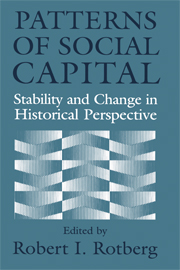Book contents
- Frontmatter
- Contents
- Introduction Social Capital and Political Culture in Africa, America, Australasia, and Europe
- Articles
- Civic Traditions in Premodern Italy
- The Sources of Civil Society in Italy
- Finding Social Capital: The French Revolution in Italy
- Social Capital in the Early Industrial Revolution
- The Diversity of Social Capital in English Communities, 1300–1640 (with a Glance at Modern Nigeria)
- Social and Cultural Capital in Colonial British America: A Case Study
- The Growth of Voluntary Associations in America, 1840–1940
- Civil Society as Democratic Practice: North American Cities during the Nineteenth Century
- Securing Political Returns to Social Capital: Women's Associations in the United States, 1880s–1920s
- Second-Generation Civic America: Education, Citizenship, and the Children of Immigrants
- Human Capital and Social Capital: The Rise of Secondary Schooling in America, 1910–1940
- From Local to National Political Cultures: Social Capital and Civic Organization in the Great Plains
The Diversity of Social Capital in English Communities, 1300–1640 (with a Glance at Modern Nigeria)
Published online by Cambridge University Press: 12 April 2010
- Frontmatter
- Contents
- Introduction Social Capital and Political Culture in Africa, America, Australasia, and Europe
- Articles
- Civic Traditions in Premodern Italy
- The Sources of Civil Society in Italy
- Finding Social Capital: The French Revolution in Italy
- Social Capital in the Early Industrial Revolution
- The Diversity of Social Capital in English Communities, 1300–1640 (with a Glance at Modern Nigeria)
- Social and Cultural Capital in Colonial British America: A Case Study
- The Growth of Voluntary Associations in America, 1840–1940
- Civil Society as Democratic Practice: North American Cities during the Nineteenth Century
- Securing Political Returns to Social Capital: Women's Associations in the United States, 1880s–1920s
- Second-Generation Civic America: Education, Citizenship, and the Children of Immigrants
- Human Capital and Social Capital: The Rise of Secondary Schooling in America, 1910–1940
- From Local to National Political Cultures: Social Capital and Civic Organization in the Great Plains
Summary
Social capital was produced by many types of human interaction in the villages and market centers of later medieval and early modern England. Each of these communities contained at least a few formal organizations that performed legal, economic, religious, and/or charitable functions. Their activities were shaped by locally influential people, mainly men, who possessed no great wealth or status when viewed from the national level but were economically self-sufficient—working from 20 to 100 acres of land or operating as craftspeople—and respected by their neighbors. The social capital generated by these organizations was of benefit not only to their own members but also externally. It was transportable and convertible, able to be carried from one group or setting to another, and it contributed to the growth of the lateral and vertical ties (both institutional and ideological) that were necessary to the emergence of a national state. Although most of these bodies were not voluntary organizations, they, and the social capital that they created, were similar to the associations studied in most of the other essays in this volume, including their implicit emphasis on men. This resemblance emphasizes that the history of community institutions that produced beneficial social capital must be traced far beyond the emergence of civil society in the eighteenth century and beyond even the Renaissance Italian city-states.
- Type
- Chapter
- Information
- Patterns of Social CapitalStability and Change in Historical Perspective, pp. 121 - 152Publisher: Cambridge University PressPrint publication year: 2000



